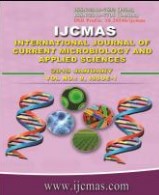


 National Academy of Agricultural Sciences (NAAS)
National Academy of Agricultural Sciences (NAAS)

|
PRINT ISSN : 2319-7692
Online ISSN : 2319-7706 Issues : 12 per year Publisher : Excellent Publishers Email : editorijcmas@gmail.com / submit@ijcmas.com Editor-in-chief: Dr.M.Prakash Index Copernicus ICV 2018: 95.39 NAAS RATING 2020: 5.38 |
Methicillin resistant Staphylococcus aureus (MRSA) is one of the most important etiology of community and hospital acquired infections. With an increasing incidence of Methicillin resistant Staphylococcus aureus (MRSA), the aim of the present study was to determine the prevalence of Methicillin resistant Staphylococcus aureus strains and their antibiotic susceptibility pattern in a tertiary care Hospital between July 2017 and July 2018. In this prospective cross sectional study, 100 Staphylococcus aureus were isolated and identified conventionally from various clinical specimens collected from different departments of the hospital. Subsequently, antimicrobial susceptibility test was performed by Kirby Bauer disc diffusion method as per Clinical and Laboratory Standards Institute (CLSI) guidelines. Among the 100 S. aureus isolates, MRSA was found to be 54% by cefoxitin (30 μg) disk diffusion method out of which maximum numbers were isolated from the age group of more than 60 years i.e. 14 isolates (25.92%) predominantly in males. Among the 54% of MRSA isolated, maximum 44.44% were from pus, 18.53% from blood, 11.11% each from sputum, urine and drain and 1.85% each from Ascitic fluid and tracheal aspirate. Among the MRSA isolated, 33.33% were from Surgery which was the highest followed by 27.78% from IMCU, 18.52% from Orthopaedics, 9.26% from Dermatology and 5.56% from Burns ward. All the isolates were resistant to Penicillin and Cephalexin, followed by Tetracycline (22 isolates), Erythromycin (21 isolates), Clindamycin and Cotrimoxazole 19 isolates each, Gentamicin (18 isolates), Ciprofloxacin (17 isolates) and Amikacin (15 isolates). All the isolates were sensitive to Vancomycin, Linezolid and Teicoplanin. Inducible Clindamycin resistance was detected in 13 isolates (24%) among MRSA isolates. Due to increasing development of resistance to multiple antibiotics, there is an increased need to find out the prevalence of MRSA and their current antimicrobial profile in order to provide appropriate therapy to the patients.
 |
 |
 |
 |
 |